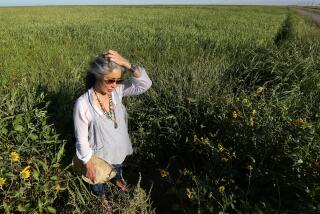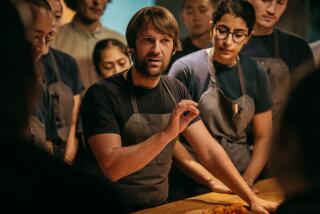Trying for the Next Phase of Green Revolution : Agriculture: A research institute seeks to boost rice production even more.
- Share via
LOS BANOS, PHILIPPINES — They call it “designer rice.”
Imagine the world’s most important food crop genetically engineered to grow sturdier and faster, produce more grain, naturally repel pests, and fertilize the soil with nitrogen nutrients the same way legumes do.
Although it sounds like a fantasy, the scenario is perhaps no more fantastic than the near-doubling of average rice yields in Asia that has occurred since the mid-1960s.
“I produce more rice, but I must buy more fertilizer,” says Nardo Militante as he walks behind a water buffalo that pulls a wooden plow similar to the one used by his father. Militante is eager to learn if new varieties of rice are available.
Militante is the kind of farmer who made the green revolution possible: He works irrigated, lowland rice fields; he has the resources to afford fertilizers and other inputs; and he is curious and willing to take risks.
Although it may not be possible to duplicate the dramatic gains in yields made the last two decades, scientists say there is scope to further increase production efficiency.
Rice is the world’s premier food. One-third of the people on earth depend on it for more than half their daily food. Asians grow and consume more than 90% of the world’s rice.
Asian rice production surged in recent decades, largely due to research by scientists from all over the world working here at the International Rice Research Institute. IRRI developed the first semi-dwarf breeding lines for rice in 1960. These fast-maturing strains were the basis for the green revolution.
In their ongoing work, scientists here are drawing on the world’s thousands of varieties of rice. One variety grows in the Himalayas at more than 10,000 feet; floating varieties grow in water as deep as 13 feet in Thailand; in Brazil rice is grown as a dry-land crop like wheat.
IRRI has categorized rice production environments into ecosystems based on water supply: irrigated, rain-fed lowland, upland, and deep-water and tidal wetlands. While the green revolution concentrated on irrigated production, IRRI’s strategy in the 1990s is to develop varieties and technologies for less-favorable environments.
For example, through continued research, scientists hope to refine a variety of rice with long, graceful stems of more than three feet, which would allow the seed-bearing stalks to float on the surface during floods in deep-water and tidal wetlands.
One of the most exciting experiments is the attempt to develop a nitrogen-fixing plant for any or all of the growing areas. Work is just beginning. IRRI will coordinate studies to find bacteria that will live in the rice root and convert atmospheric nitrogen into nitrogen compounds that help fertilize the plant.
“Once suitable organisms are identified, these and the rice plant can be genetically engineered to provide the proper chemical signals for the bacteria to live in the rice root,” says Gurdev Khush, head of IRRI’s Plant Breeding, Genetics and Biochemistry division.
Although it is certain that biotechnology and extension work aimed at getting technology to farmers will extend the gains of the green revolution, there are still many questions. And funding for activities is in short supply.
Most dismaying, however, is the continued challenge of population growth. In 30 years the population of Asian nations where rice is the preferred staple is projected to surpass 4 billion. To meet their needs, annual rice production would have to increase from today’s 500 million metric tons to 760 million tons.






